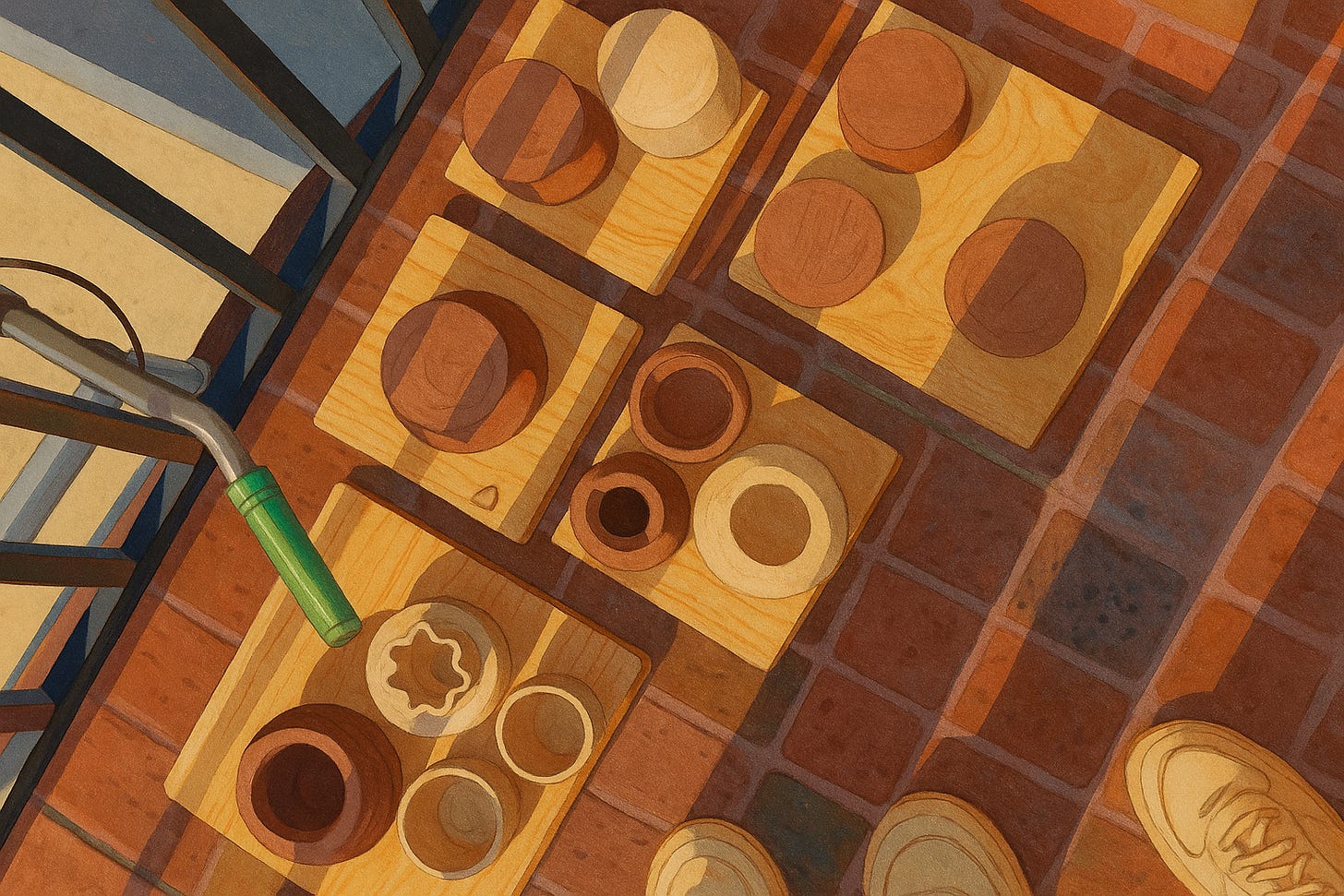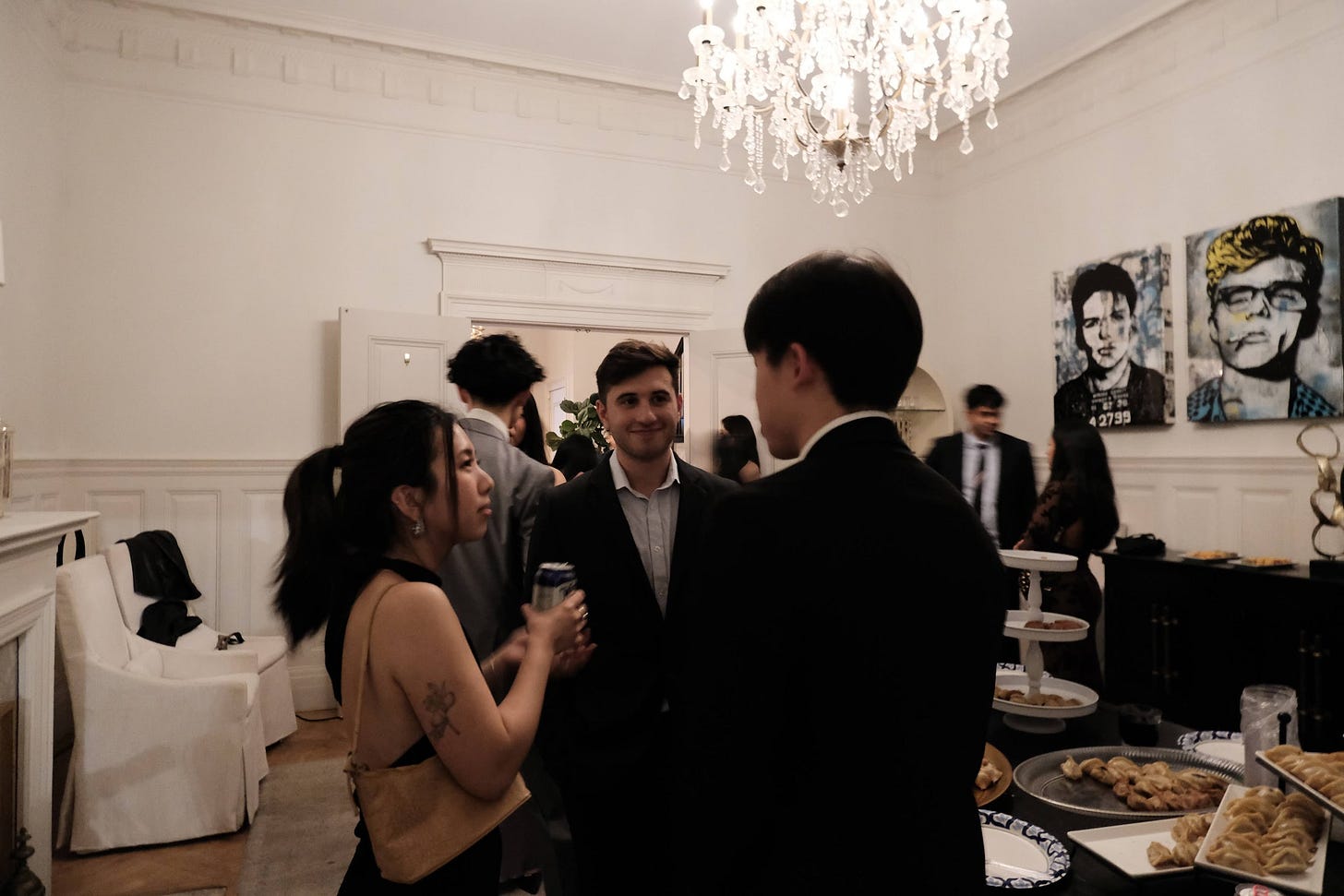A few months ago, I wrote about wanting to start pottery. I just finished a 12-week beginners wheel throwing course. I set out to make something beautiful. What I ended up with was a lumpy collection of bowls and a better understanding of my own wiring. Turns out, the way I approach pottery isn’t so different from how I approach software, writing, or most things in my life.
I came into pottery wanting to learn something new, work away from screens, maybe meet people, and create pieces I'd be proud of. Three months later, I can confidently say I’ve learned something new and reduced my screen time. I didn’t make studio friends, and none of my pieces are prize-worthy, but the process taught me more than I expected.
Last night was our final class, a day to glaze our pieces and apply finishing touches. I looked around and most of my classmates had 2–3 pieces to glaze. They moved slowly, brushing on the glaze with care, polishing every detail as it dried. Meanwhile, I was racing against the clock to glaze 13 pieces1 before studio closing time.
You’ve probably heard the parable2: A pottery teacher divides his class into two groups. One will be graded on quantity (the # of pots). The other will be graded on quality, needing just one perfect pot. At the end of the course, the best pots all come from the quantity group. They made mistakes, learning with every attempt. The quality group, meanwhile, spent their time theorizing about perfection and ended up with nothing to show but a single mediocre piece.
My instructor told us this story early on, hoping to free perfectionists from their overthinking cycles and iterate more. I don't think I needed this encouragement. If anything, I took it too far.
All semester, when given the choice between quality and quantity, I chose quantity. Even when I tried to fight it, I defaulted to more reps over perfecting a single piece. It was freeing. If something turned out lumpy or collapsed, I didn’t dwell. I’d just cut it off the wheel and start again.
One night, I became fixated on a bulbous shape. I threw pot after pot, adjusting the curve and pressure, but each collapsed when I narrowed the neck. I wasn’t precious about any single piece. Each failure just fueled the next attempt. I didn’t leave the studio until closing.
My bias toward action has served me well in other parts of life. In software or writing, shipping more usually sharpens instincts and leads to better work. But clay didn’t reward speed in the same way. I could crank out volume, but without slowing down, I missed chances to actually improve. Clay demands a kind of tactile precision that brute-force repetition doesn’t teach. If I was distracted or frustrated, it showed. The walls of my piece were more likely to fall in. And unlike code or drafts, I couldn’t edit mistakes later. While I made more pieces than most of my classmates, theirs were objectively better. Their restraint had paid off. It made me realize that maybe my tendency to favor volume could be tempered by more patience.
I was reflecting on my pottery experience today when my coworker3 shared something his scientist father used to say: there are two types of researchers. Elephant chasers spend careers grinding on a few core problems, taking big swings with hyper focus. Dandelion chasers work on many topics, churning out paper after paper — some good, some bad, but a few great ones usually emerge from high output. Both approaches produce similar amounts of excellent research over time.
The danger is getting stuck in the middle. Not focused enough to go deep, not fast enough to learn broadly. You end up with no good work.
In pottery, I’m definitely a dandelion chaser. Many pieces, many attempts, many experiments with glazes and shapes. It mirrors how I work in most areas of my life: iterate quickly, try lots of things, don't get too attached to any single attempt.
My coworker made another point: people can switch modes depending on the context. I perceived him as an elephant chaser at work, someone who is great at identifying and executing on high-impact projects where stakes matter. But he said he actually feels more like a dandelion chaser on side projects, where lower stakes make experimentation fun.
I’m usually biased toward action. I like having a plan, but I try not to dwell on it for long. I’d rather get started and figure things out as I go. That instinct has served me well, especially in fast-paced environments like software and startups. But pottery reminded me that while I may be a dandelion chaser at heart, growth doesn’t come from output alone. It comes from noticing what each attempt is teaching me, and choosing when to slow down enough to actually learn it.
I hope I’m still living out the pottery parable and just haven’t hit the part of the curve where my pieces start to look polished (Or maybe that’s just wishful thinking.)
some other thoughts on pottery
One-way doors reveal themselves quickly in clay. You can keep reshaping a piece while it's wet, but forget to cover it overnight and your options vanish. You can trim a piece if its leather hard but too wet and it will collapse under the pressure. Fire it in the kiln and the shape locks in permanently.
Pottery requires planning. When I’d come back to trim a piece affected how I packed it up right after throwing.
A lot of new music from the last few months came from pottery sessions. I'd been feeling bored with my playlist and looking for new sounds. Listening to entire albums while my hands were occupied was a good way to find new music.
I joined the studio thinking I'd find pottery friends. I ended up mostly alone with my thoughts — listening to podcasts, music, or sometimes a friend on FaceTime while she told stories as I trimmed my pieces.
recently
A little snapshot of what I’ve been up to and what’s on my mind.
Went to my friend’s Sangeet celebration. It was my first time going to Indian wedding festivities and I admired the care everyone in the wedding party put into learning group dances and putting on a show.
We hit a 13 week streak for our morning reading group! Every week at 8am, we meet to read together4 and catch up before work. I started it to build better reading habits and also as an excuse for a recurring catch-up with friends. It’s become a lovely morning ritual.
My friends hosted Matchmaker’s Manor over the weekend and it was so much fun to play cupid for our friends. Daniela wrote about the event on her blog :)
Spent the weekend in British Columbia at Anson’s farm. We harvested eggs, slaughtered chickens, cooked a whole goat, ate many watermelons, built The Structure™, made friendship bracelets, played mahjong. It was a nourishing weekend.
asks
I’ve been listening to Noah Kahan, Hazlett, Gracie Abrams, Ocie Elliott, Chance Peña, Mindchatter, Bonobo and Wild Rivers on repeat recently. Would love recs in a similar vibe :)
I’d love recommendations for essays, books, or writing that’s meaningfully changed the way you think or approach your work
Rabbitholeathon 6.0 is happening! Rabbitholeathon is a weekend retreat dedicated to curiosity, exploration, and diving down rabbitholes with other ambitious thinkers. Tell your curious friends to apply!
This might be more of a signal on my tendency to procrastinate.
More on this in The Parable of the Pottery Class by Ali Abdaal
Thanks Grady for talking through these ideas with me and letting me adopt the terms dandelion and elephant for this post :)
Inspired by the reading group that Leslie, Queenie, Twinkle and co. (aka. the queens of East Village) started a few years ago.










I love the analogy of dandelion chasers! Been loving your updates, keep them coming :)